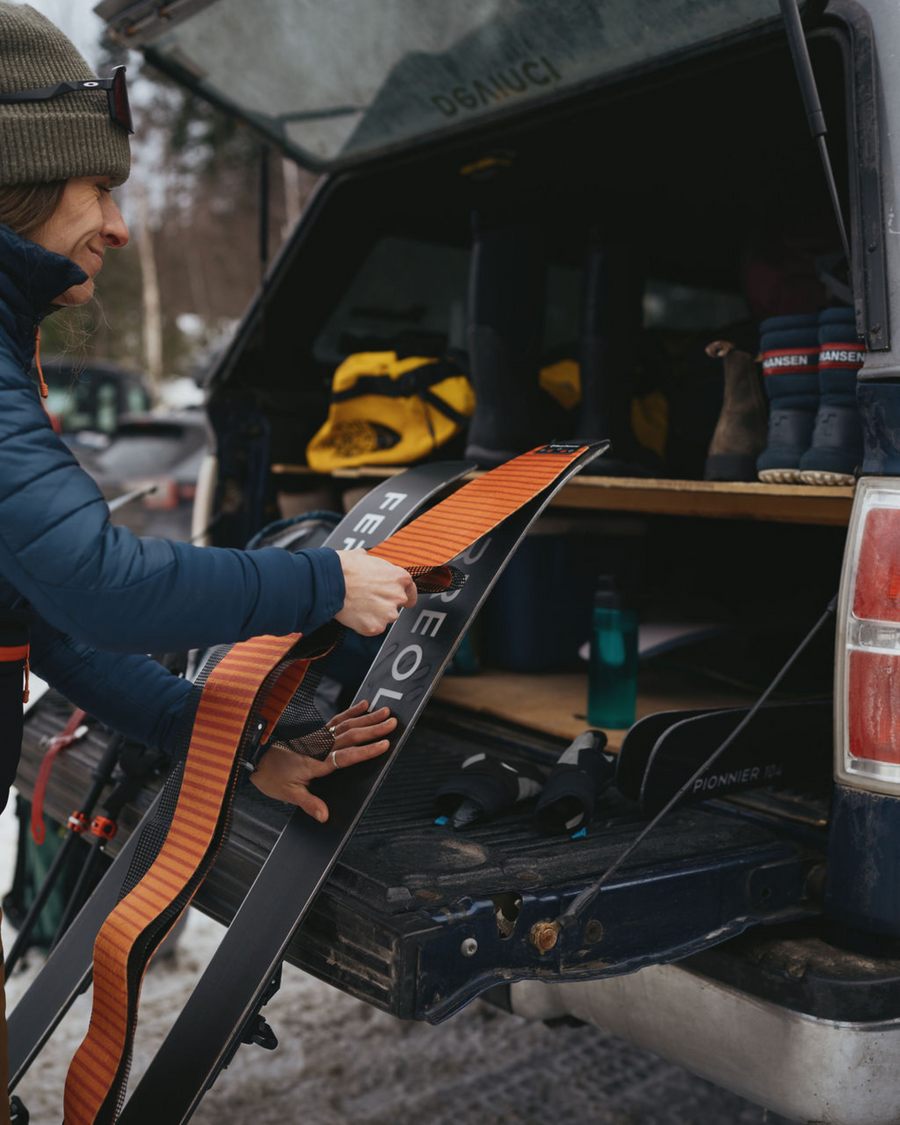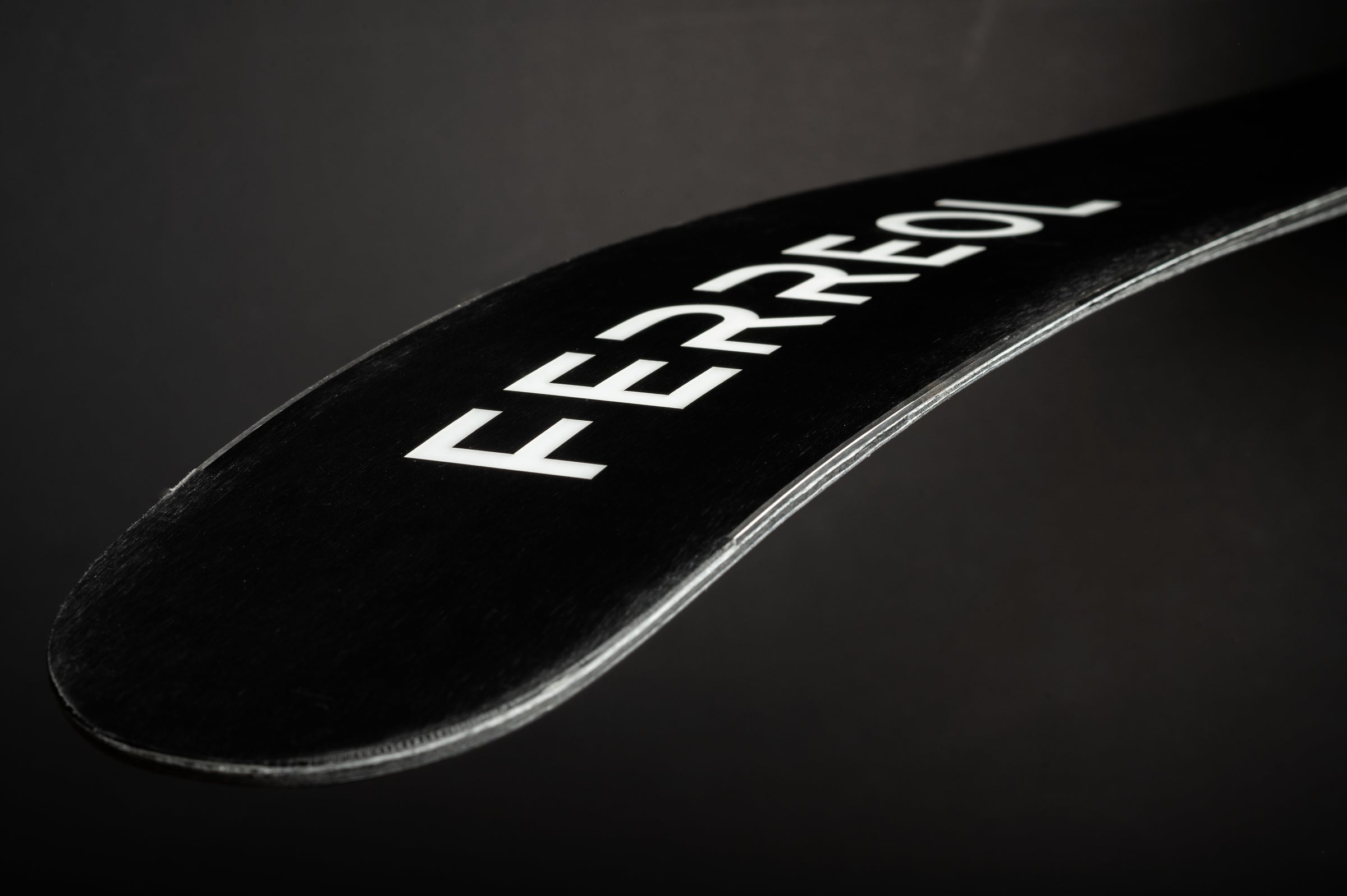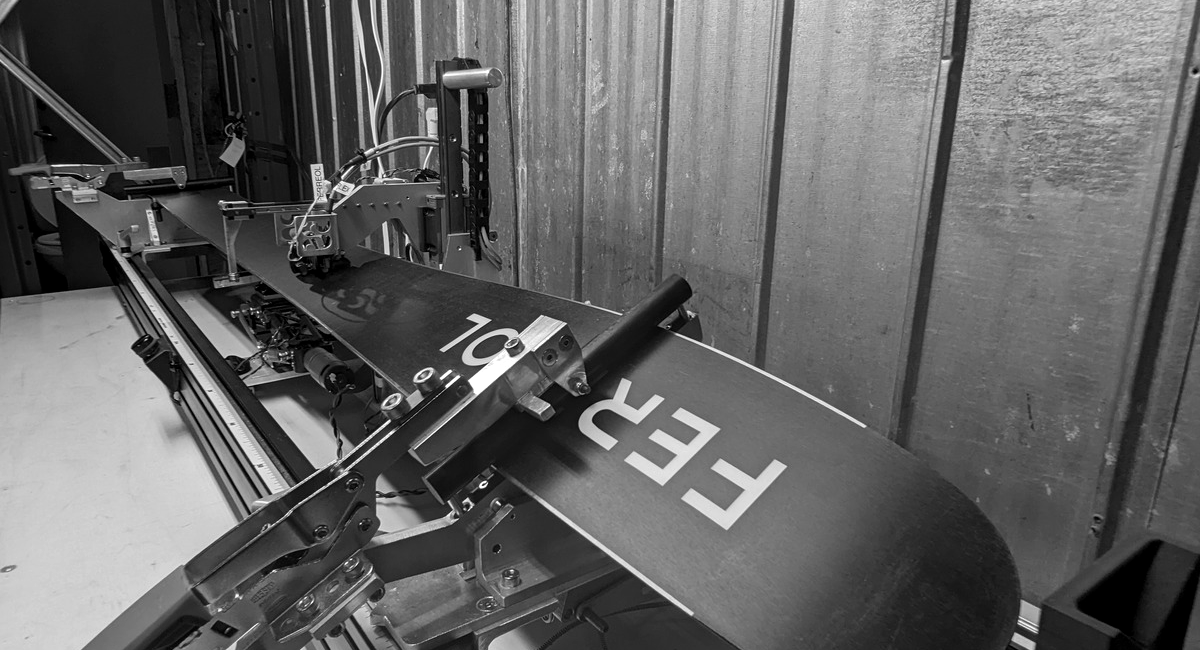3P CAMBER
The 3-point camber maximizes the ski's grip and stored energy, without compromising its agility. Instead of uniform pressure along the ski's edge throughout a turn, three distinct high-pressure zones are created. This blog will first explain the physical nature of the 3P camber, followed by a detailed exploration of the advantages and workings of this technology.
What's the 3P camber ?
The Three-Point Camber (3P) is the exclusive camber of the Pionnier 104 and the Explo 96. This camber has a distinctive shape that sets it apart from the camber of other skis. When flattened, the 3P camber creates three narrow contact zones. In other words, the area between the front of the foot and the beginning of the front rocker is slightly elevated, and the same applies to the area between the back of the foot and the start of the rear rocker.



The 3P camber of the Pionnier 104 and the Explo 96 is designed to maximize pressure in these 3 contact zones while minimizing the length of contact. With the help of our tools and Sooth Ski, we can precisely predict the deformation of skis when they are put on edge. The actual deformation of the Pionnier 104 (172cm) is compared to that of a ski from another brand. For the Pionnier 104 in blue, you can see that when the boot center touches the ground, the ski is not in contact with the ground immediately before and after the foot. For the ski in orange, the entire ski comes into contact with the ground, creating a more uniform pressure.
The keen observers among you might have already noticed this phenomenon on other skis. Indeed, some skis with a lot of camber can also exhibit this behavior. However, other skis don't do it as pronouncedly as the Pionnier 104 or the Explo 96. For this reason, our off-piste skis offer a unique on-snow behavior that provides a strong energy return at the end of a turn while remaining agile and playful.

What's the point of 3P camber?
After all these explanations, it's still valid to wonder about the purpose of the 3P camber. This technology serves to reduce pressure at the ski's tips during low angles of attack. Lower pressure at the ski's ends results in greater ease of pivoting. This behavior is often referred to as "playful" or "agile." This is what makes the Pionnier and the Explo perfect skis for navigating tight turns amidst the trees in your favorite glades. However, when the ski is put on edge at a steeper angle, such as in a situation of tight-radius carving, the 3P camber behaves like a normal camber and transfers more pressure to the ski's tips. This allows the ski to maintain good grip while enabling a quick energy return. The result? Exciting and versatile skis that will maximize your enjoyment throughout the season!
STIFFNESS DISTRIBUTION
When the time comes to replace your old skis with a new pair, it's often a challenge for some to choose the right model. Participating in a demo day to try out different models is an option, but not all skiers have that time, and sometimes not all models are available. The solution then is to rely on the information provided by various manufacturers. However, each has their own way of presenting their skis, making it not easy to navigate through.
We've provided you with the flex distributions of our skis. A numerical and objective way to inform you about this mysterious yet crucial property of skis: flex. More transparency, more information, but also more questions.
This ski has a 100mm waist, a 20m radius, and is 180cm long. It seems to match my needs, but is it stiff or soft? "This model has a flex of 8/10." But what does that mean?
What is the stiffness distribution of a ski?

Bending stiffness
How difficult it is to flex a ski
Symbol: EI, measured in Nm²

Torsional stiffness
How difficult is it to twist a ski
Symbol: GJ, measured in Nm²
Why are we interested in the stiffness distribution?
The stiffness of a ski greatly affects its behavior on the snow. Indeed, the stiffer a ski is in flexion, the more stable it will be at high speeds. Torsional stiffness is also important. The stiffer a ski is in torsion, the better its edge hold will be. However, a softer ski will be easier to skid and easier to turn. This is why the stiffness of skis will vary based on the intended use.
Furthermore, the ski's behavior can also vary based on its local stiffness distribution. Let's imagine two skis with equal average flexion stiffness. If we only consider the average stiffness, we might think that the skis would have the same on-snow behavior in terms of flexion stiffness. However, one ski could be softer at the back and the other at the front. Therefore, they may not have the same behavior. This is why stiffness distribution matters, and it's not necessarily sufficient to only look at the average stiffness.
How is the stiffness distribution measured?
To measure the flexion stiffness distribution of a ski, a known force is applied to the ski, and the ski's deformation is measured at every point. To measure the torsional stiffness distribution of a ski, a known torque is applied to the ski, and the angle of torsional deformation is measured at every point. A research group at the University of Sherbrooke, supervised by Alexis Lussier-Desbiens, has developed a machine capable of measuring these two parameters, as well as the ski's geometry and camber, all in less than 2 minutes. Now operated by Sooth Ski, this technology is what Ferreol uses to measure the mechanical properties of its skis.
Case study: The Explo 96
Our design process aims to reduce the number of prototypes needed to reach the final concept. After designing the geometry of a new prototype and creating a first-scale model, we select different materials and their configuration to achieve the desired flexion and torsion stiffness. Finally, we manufacture a first prototype at our Beaupré facility to test it on the slopes of Mont-Sainte-Anne. On-snow tests are the last step of a design cycle. This is where we must put engineering aside a bit and rely on the experience and evaluation of our testers. If the ski behaves as expected, the design is completed. Otherwise, adjustments are necessary.
In the case of the Explo 96, our testers indicated that the ski was agile and easy to control, but it could benefit from being more spirited and stable in bumps or variable terrain. Therefore, our designers decided to increase the front (tip) stiffness of the ski to address this issue.
The figure below shows the stiffness distributions of one of the initial prototypes of the Explo 96 (orange) and the final version (blue).
By increasing the front (tip) stiffness, skiers can have a more aggressive stance (more weight forward) and enhance the ski's stability in bumps and variable terrain. However, by keeping the rear (tail) stiffness lower, skiers can exit turns at any time and initiate a skillful skid to quickly control speed and direction.
The result? An energetic and agile ski that performs well in tight glades and on firm snow.
To summarize, if our designers had only focused on average stiffness, it would have been impossible to conduct this analysis and optimize the behavior of the Explo 96. This is why measuring stiffness distributions is an important tool in our design process.


PIONNIER 104
The Pionnier 104 has higher bending stiffness than the average (upper curve). Twinned with his camber pronounced, the Pionnier promises an energetic return to the output of the turn. In addition, its more flexible rear spatula absorbs the unexpected.
The stiffness in moderate torsion for its size ensures a good hold of the crossroads while keeping the Pionnier 104 agile and versatile.

EXPLO 96
The materials of the Explo were chosen to achieve a balance between weight and stiffness in order to mke it a ski capable of standing out in all the conditions found in Quebec. For its size, it has a high torsional stiffness which gives it a good grip on firm snow. Coupled with its rockers, this makes it a very versatile ski.

Zigzag 92
The Zigzag offers a little more flexibility in spatulas than the Explo, which allows more control and agility for your figures or side hits. In addition, its torsionl stiffness is high under the foot, but moderate to the spatulas to allow you to get out of any situation. Finally, thanks to its short radius, you will be surprised by how much you can push this ski in your turns.

Surfeur 112
The stiffness of the Surfeur was first optimized to ensure optimal flotation which minimizes the sinking of skiing in the snow. This provides better glide in deep snow, but also better control to surf the snow. Despite this, the Surfeur retains the versatility and the signature agility of Ferreol.
With its short radius for a ski of this size and its stiffness in high torsional under the boot, you will be surprised by the grip and tight turns that this ski can make on a firm surface.




